Low Attachment. High Commitment.
Maya sits in the conference room, laptop open, staring at the investor's message that just pinged through: "Investor call moved up to tomorrow. Want to see an update on growth." Her coffee has gone cold. Her heart rate spikes. Her AI startup that felt so crystal clear six months ago: the one that would revolutionize customer service, the one her co-founder Marcus believed in enough to quit Google a year ago, suddenly feels like it’s slipping through her fingers.
She refreshes her dashboard. Still the same numbers. Still not growing fast enough.
The enthusiasm that once carried her through eighteen-hour days now feels like a distant memory, replaced by something heavier. Something that tastes like doubt.
The rollercoaster had officially begun.
The Rollercoaster Every Founder Rides
”Building a successful company is easy!”
- said no founder ever.
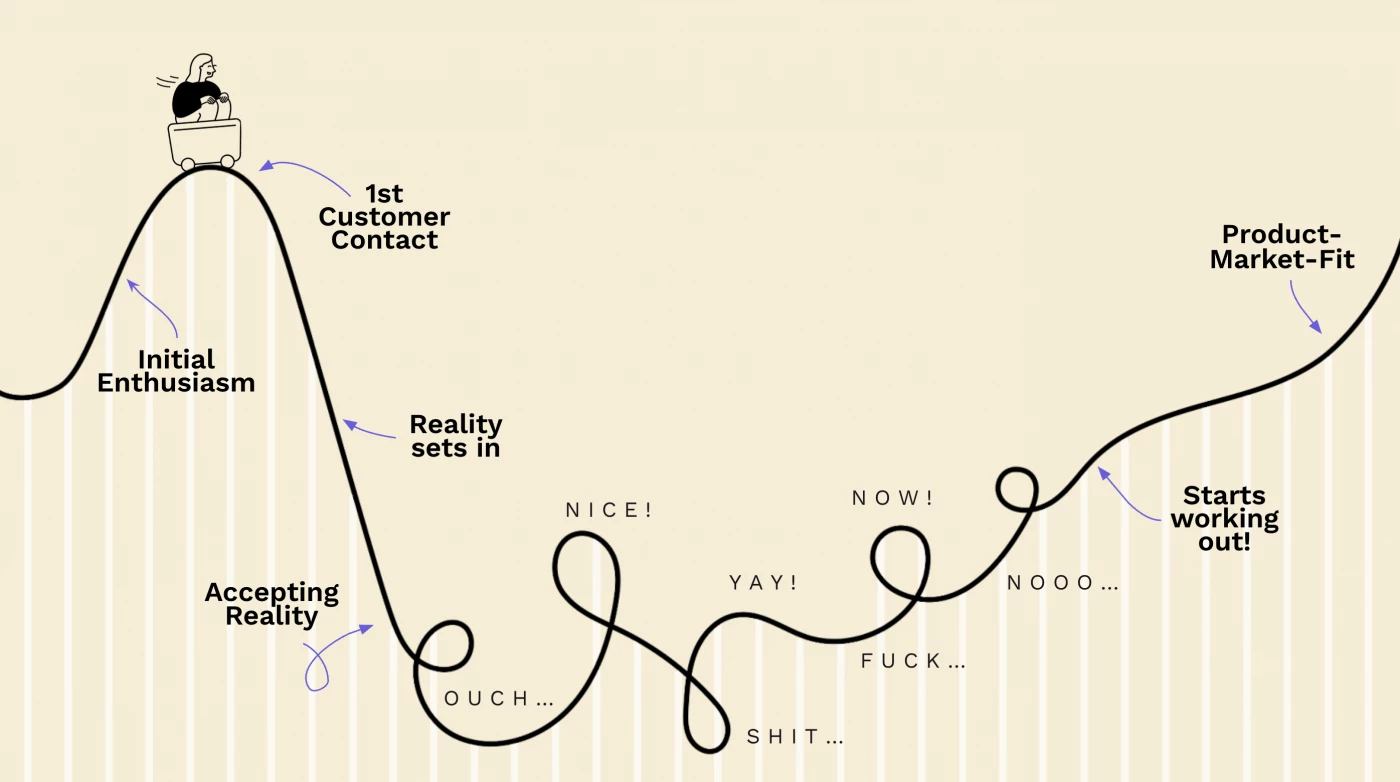
Every founder eventually faces this moment. The one where reality pulls you down like a rollercoaster in freefall with no warning.
Most founders start the same way Maya did: with that exciting initial enthusiasm. The vision is clear. The market opportunity feels obvious. The prototype works. The co-founder says yes. Everything aligns perfectly, like puzzle pieces clicking into place.
Then the rollercoaster begins its first unexpected drop.
Because here's what we forget in those exciting, fast-paced early days: a startup is uncertain by design. It's a hypothesis: a search for a scalable, repeatable business model.
The ups and downs become relentless. One moment you're holding a term sheet, the next your biggest customer is churning. One hour, you feel like you're changing the world, the next you're questioning whether you're competent enough to run a lemonade stand.
Most founders feel this rollercoaster in their bodies: heart racing, palms sweating, thoughts spiraling. They ride every loop, every twist, every stomach-dropping fall. Their nervous system mirrors the business metrics. It becomes shaky when growth slows and euphoric when deals close.
And here's the bad news: our brains are designed to focus on what's going wrong. Research shows that losses feel roughly twice as painful as gains feel good (a phenomenon psychologist Daniel Kahneman called "loss aversion"). It takes between three to five positive interactions to offset the emotional impact of just one negative experience. So buckle up for a rollercoaster with many more drops than climbs.
When Proven Strategies Stop Working
After the investor's message, Maya was still searching for clarity. At the same time, more and more information kept pouring in. Fires popped up. Team members needed decisions. Suddenly, everything felt urgent. And impossible. Chaos. Panic. Not a single clear thought.
How was she supposed to show a clear path forward tomorrow?
So she called a founder friend, someone who had scaled a SaaS company (totally different market, but close enough) and had become a kind of mentor.
"Got any tactics that helped you grow?" she asked. Fifteen minutes later, Maya was back at her desk.
She didn't fully understand the framework he had shared, but it gave her something to hold onto. She started putting together a few slides with scattered ideas and vague tactics. It wasn't perfect. But better than showing up empty-handed, she thought.
When the uncertainty hits, most founders do what feels natural: they grab for control. They dive deeper into the outer game (the tactics, the playbooks, the technical solutions):
"How should we structure our OKRs?"
"What's the best fundraising strategy?"
"Which growth hacks are other companies using?"
They ask mentors, consume case studies, and rely on frameworks. All are searching for that magic recipe for success that will make the chaos predictable.
Here's what happens: following these recipes creates the illusion of control. For days, maybe weeks, you feel steady. The framework seems to work. The playbook seems to make sense. You're executing like the unicorn founder who wrote the case study.
Then you taste the soup halfway through. You realize the growth hack isn't working. The OKR structure feels forced. The fundraising strategy that worked for that other company is falling flat with your investors.
Suddenly, the shakiness hits twice as hard. Not only is the tactic failing, but now you're questioning your ability to execute "proven" methods, and you lost another two months of runway. The framework promised certainty, but delivered deeper doubt.
Here's the truth most founders resist: no amount of tactical brilliance can compensate for a shaky inner game. Every startup is made of different ingredients. Copying someone else's recipe won't guarantee the same result, and when you follow it expecting guaranteed success, the inevitable setbacks feel like personal failures rather than natural course corrections.
Understanding the Founder Psychology behind
The most underrated game isn't happening in your product roadmap or your fundraising deck. It's happening inside your head, in the dance between your beliefs, thoughts, and emotions.
Let’s call it the inner game of entrepreneurship, and here's how it works:
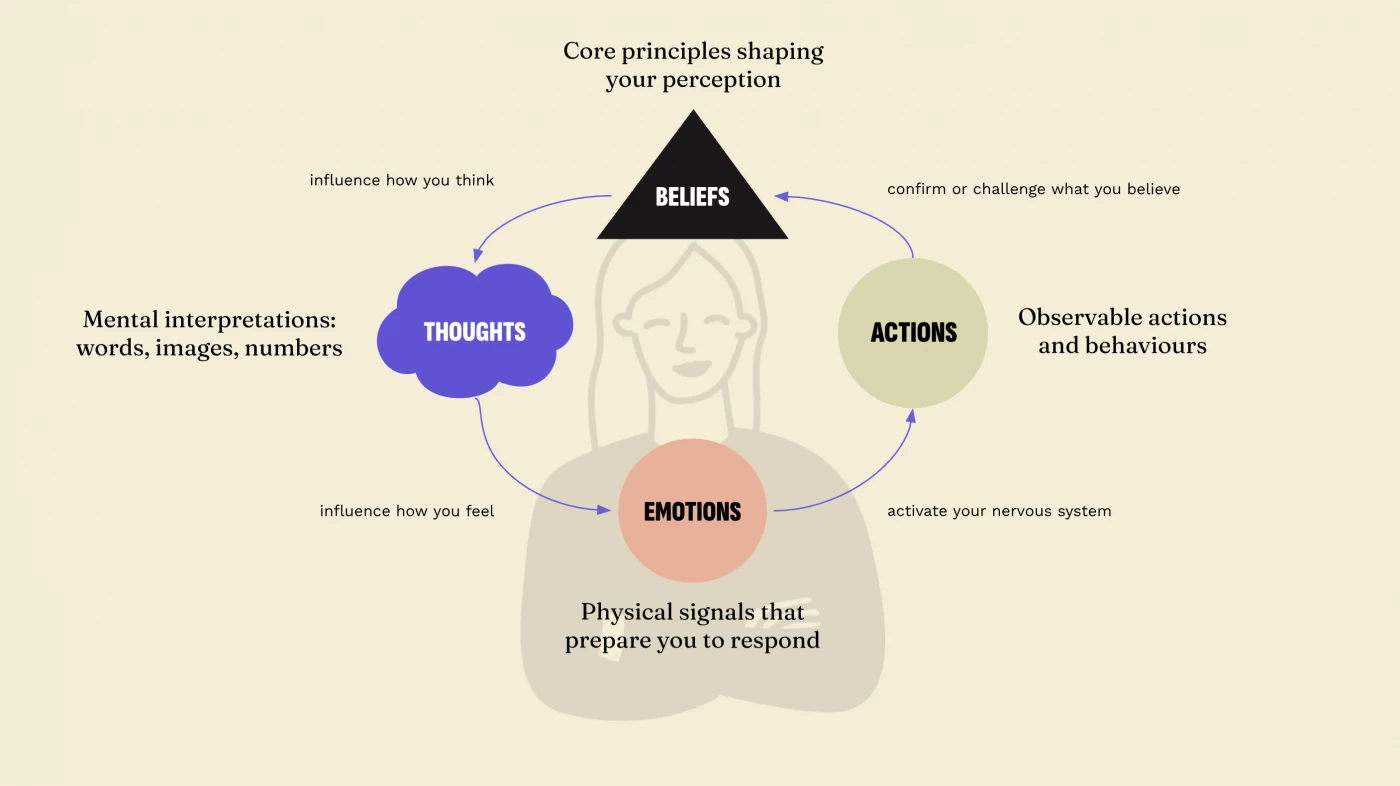
Beliefs are the organizing principles of your psychology. Imagine it like the core of your psychology that influences everything else. They form quickly through what you hear, experience, and the feedback you get.
There are two types of beliefs:
1. Supportive beliefs:
“I’ve got this!”
“I have the resources to get through this!”
2. Limiting beliefs:
“I’m not good enough.”
“I’m not safe.”
Your beliefs influence your thoughts and emotions.
Your thoughts and emotions influence your actions.
Your actions reinforce your beliefs.
And the cycle continues. [1]
That’s the endless feedback loop of your psychology and the lens through which you experience the world.
Thoughts can be statements, pictures, numbers, or words. You have thousands of them in your mind each day.
Emotions are mental states felt in your body as physical sensations. They are predictions that activate your nervous system and shift you into different modes:
- Regulated mode: You think clearly, see opportunities, and collaborate well.
- Fight mode: You become protective, argumentative, and push harder.
- Flight mode: You avoid, procrastinate, or freeze under pressure.
As a founder, you build skills in each category: beliefs, thoughts, and emotions.
Emotions are the most underrated. Founders feel them intensely during the startup rollercoaster, and that’s normal. They won’t stop after your next big funding round. They’re not good or bad. They don’t make you weak. They just make you human.
They’re neutral data. Learn to read them, and you gain a competitive advantage.
This system is unique to you. It's your reality-creation machine, complete with confirmation bias and a thousand other cognitive shortcuts. How you perceive that board meeting, that growth question, that investor's tone: it all gets filtered through this internal matrix.
Maya reaches out to Marcus: "I don't feel great about the board meeting tomorrow. I'm afraid the board will fire me because I'm incompetent and can't make our business grow fast enough." Marcus reacts with surprise, maybe even a bit of frustration: "Wait, what?! How do you come up with such a thought? They just want to offer their help to us."
What Maya and Marcus don't realize is that Maya grew up in a very conservative family. Her parents, both academics with years of research experience, drilled one core belief into her: you need to be competent, never show you don't know something. That belief made Maya read the same data Marcus received in a completely different way.
Her thoughts immediately started creating scenarios of how the meeting would go. Her mind stressed her to find competent answers to challenging questions. But she couldn't find them. The thought spiral accelerated the moment she realized she didn't know for certain how the company could grow faster. Her emotions predicted a future where she saw herself arguing with the board, fighting for her position as CEO.
Two Founders, One Question, Two Realities
Consider Maya and Marcus facing the identical situation the next day: an investor asking, "Why aren't you growing faster?"
Maya feels her heart racing. Heat rises in her chest. Thoughts spiral: They think I'm incompetent. What if they don't support the next round? What if I'm not good enough for this? The emotion is pure threat. Her nervous system floods her with adrenaline (the body’s fight-or-flight fuel) and then with cortisol (the hormone that locks her mind onto danger). She gets defensive, narrow-minded, and protective. Every word she speaks comes from a place of damage control.
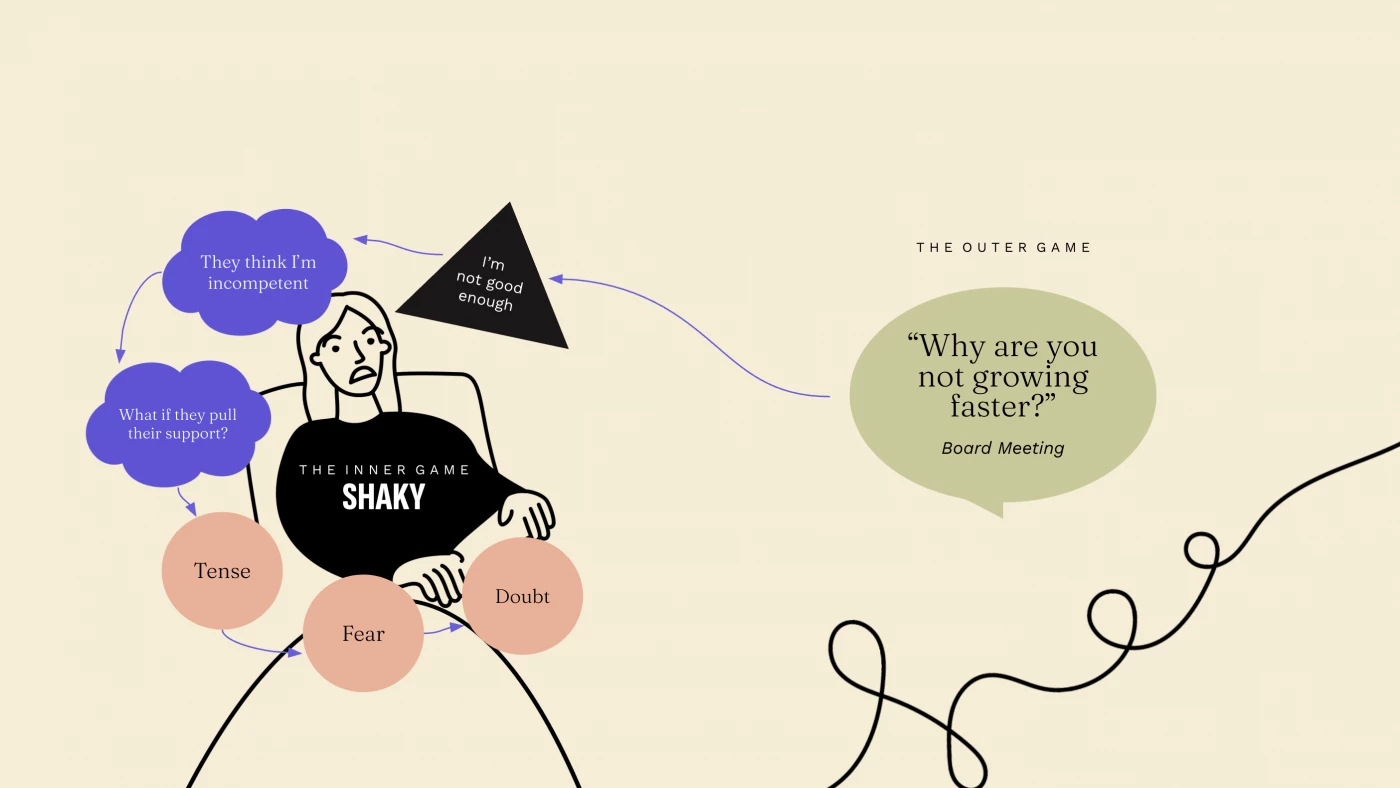
Marcus notices the same question but processes it differently. His thoughts shift: They're right. We aren't growing fast enough. Good thing they're addressing it. I wanted to tackle this anyway. How can I use the expertise in this room to solve this together? He sees opportunity instead of threat. His nervous system stays regulated. He becomes curious, open, and collaborative.
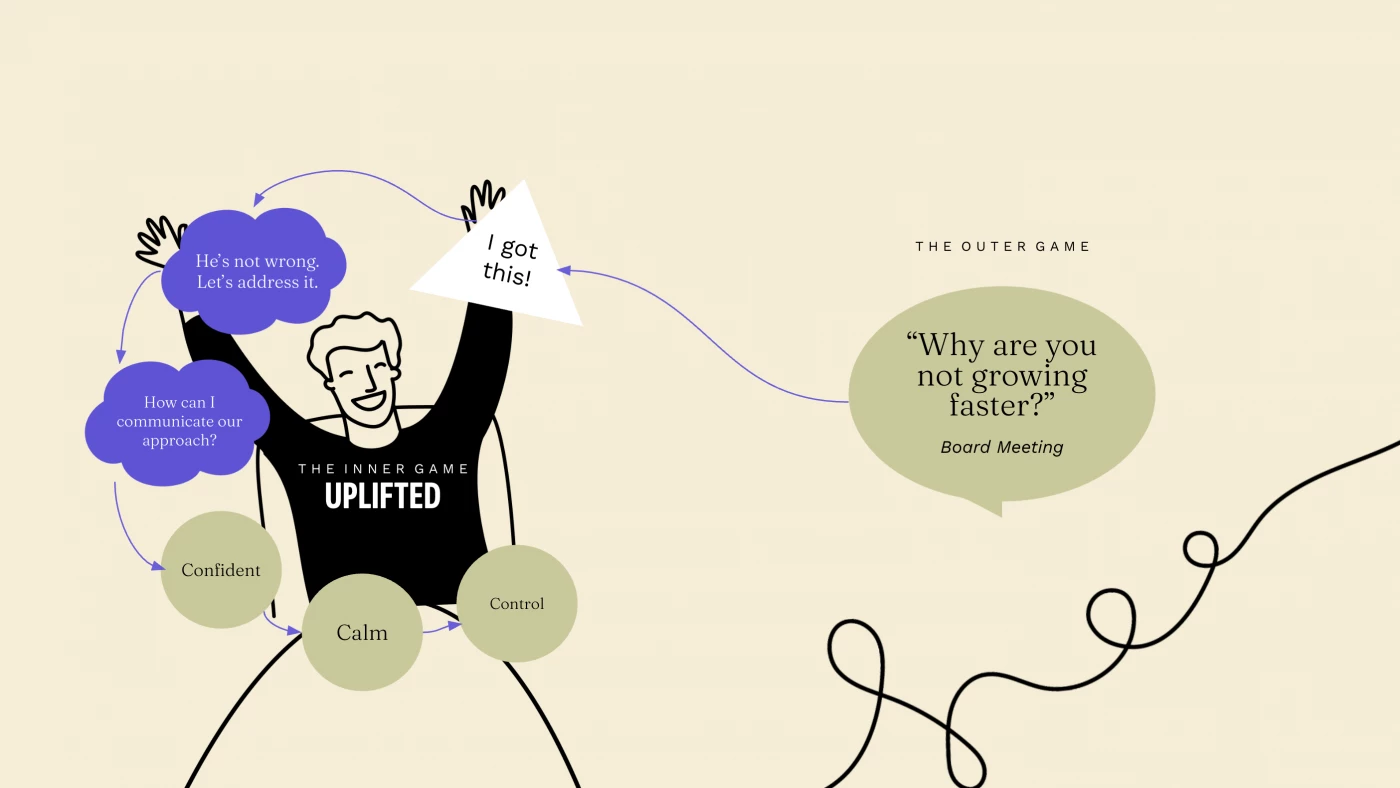
Same question. Same room. Two completely different experiences of reality.
The difference isn't talent or luck or market conditions. It's an attachment.
Remember: beliefs are your interpretations of how the world works. Your brain uses them to make sense of what's happening, shaping your expectations, your sense of safety, and how you think the future will unfold.
The stronger the belief, the more it becomes part of your identity. That's when attachment kicks in.
You don't just want something to happen, but you need it to. Because if it fails, you feel like a failure. Your identity gets questioned. A very common limiting belief and attachment for founders:
"If this startup fails, I'm a failure."
Which Type of Founder Are You?
Through over 1,000 coaching sessions with hundreds of founders, we've identified a pattern that separates those who scale from those who flame out. It comes down to two dimensions: attachment and commitment.
Attachment means how strongly you’re emotionally tied to your beliefs, identity, and desired outcomes.
Commitment is your willingness to face hard truths and take bold action.
We've identified four distinct patterns in how founders handle the relationship between attachment and commitment.
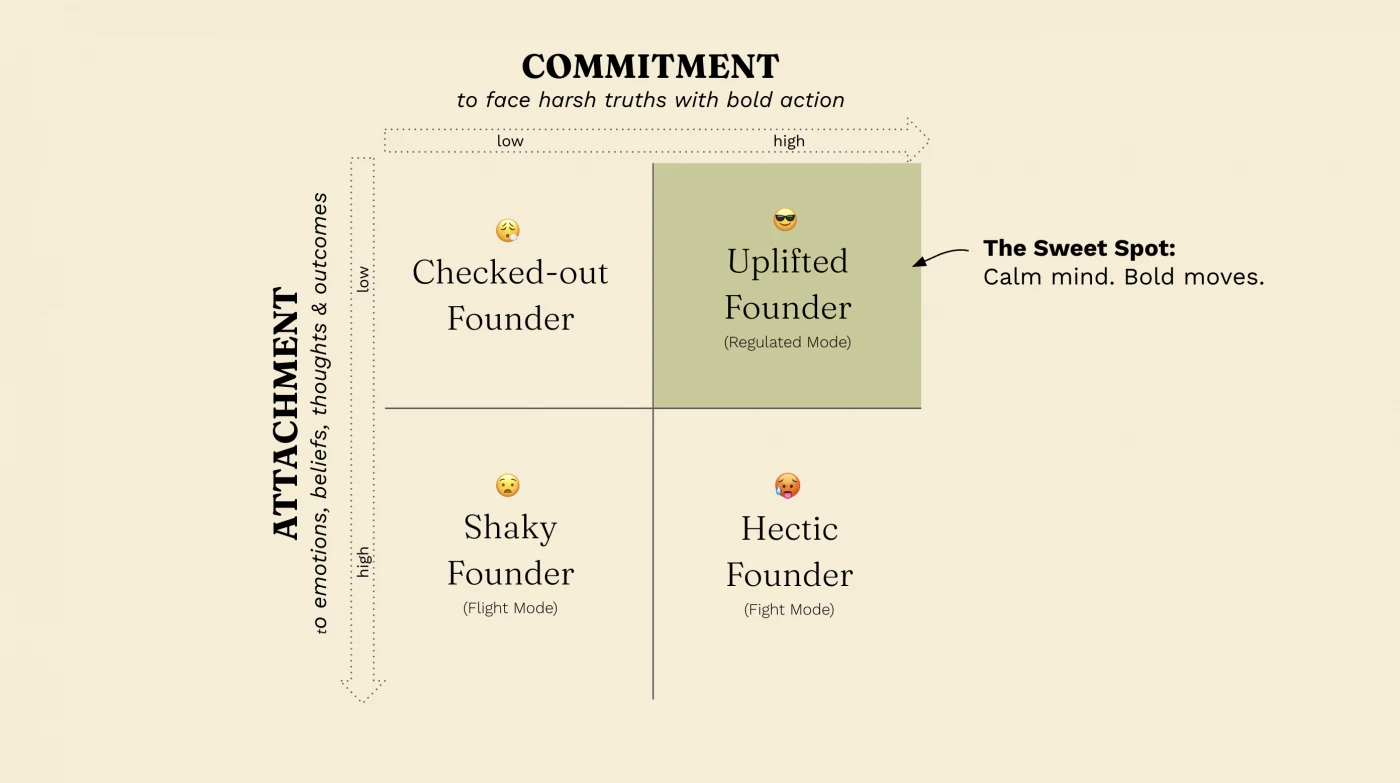
The Shaky Founder (High Attachment, Low Commitment)
feels every bump in the road like a personal attack. When growth slows, they don't just see a business problem. They see proof of their inadequacy. They avoid difficult conversations, delay hard decisions, and get caught in loops of anxiety. The rollercoaster owns them completely, and they tend to cope with flight mode (avoidance, withdrawal, or freezing under pressure) reactions.
Here's the hard reality: we see many people join startups only to realize they aren't made for it. If you find yourself in constant flight mode, it might be a sign that this path isn't for you, and that's okay. Constant shakiness without commitment may be a signal that you've gotten into something you're not wired for. There's wisdom in recognizing this early rather than suffering through years of misalignment.
The Hectic Founder (High Attachment, High Commitment)
charges forward with admirable determination but carries too much emotional weight. They'll face the hard truths and take bold action, but they're running on adrenaline and emotional reactivity. This leads to burnout, blind spots, and decisions made in fight mode (confrontation, urgency, or overreaction under stress) rather than from clear thinking.
This is actually where we see 80% of founders, especially when they do it for the first time. The good news? It means you care and you’ve got the energy this game demands. We know for a fact that detachment can be trained. A recent study from the University of Liège found that serial entrepreneurs develop distinct neural patterns for cognitive flexibility, literally rewiring their brains to adapt thinking strategies more quickly.
The Checked-Out Founder (Low Attachment, Low Commitment)
has emotionally disconnected from the venture. They're no longer riding the rollercoaster, but they're also not steering the ship. This founder has given up without admitting it, going through the motions while their heart is elsewhere. That can be completely normal. It’s part of the journey. We’ve seen founders grow companies to 8-digit ARR in just a few years, only to realize they weren’t the right fit for the next phase. It’s a sign of strength to say: This role isn’t mine anymore.
The Uplifted Founder (Low Attachment, High Commitment)
has found the sweet spot. They care deeply (they're not emotionless robots), but they don't tie their identity to every outcome. When losses happen, it feels like losing a game, not losing their life. They can observe the rollercoaster while making clear-headed decisions about how to ride it. They have a full life outside of work with hobbies, family, friends, and other things that define them. And that often makes them move faster, take bolder steps, and show up with more energy. They know that experimentation is part of entrepreneurship, and most experiments fail. That's not a character flaw; it's the game.
Maya's Path from Shaky to Uplifted
The shift from shaky to uplifted isn't magic. It's trainable. Here's how Maya made this transformation, and how the same pattern works for any founder ready to change their relationship with uncertainty.
Facing What She'd Been Avoiding
After that conversation with Marcus, Maya sits alone in her apartment at 2 AM, laptop closed. The board meeting is tomorrow, and she can't sleep. Instead of reaching for another framework or scrolling through founder advice threads, she does something different: she calls me (her coach).
"I can't keep doing this," she says on our first coaching call the next morning. "I'm completely losing it over this board meeting, and I know that's not normal. Something needs to change, but I don't know what."
I can hear the shakiness in her voice, the way her words are coming faster than her breathing. "Maya, let's drop into this moment. Take three deep breaths with me. In through your nose... out through your mouth."
She follows along. I can hear her settling.
"Good. Nothing to solve right now. Just you, me, and the truth. What's actually happening here? Not the story, not the spin, what's the truth you've been avoiding?"
She's quiet for a long moment.
Then: "We're not growing fast enough, and I've been hoping it would fix itself instead of facing how serious this is.
Honestly, I had felt it for a while. The tactics we were testing weren’t sticking, and I started to panic. But I kept telling myself this was normal and that one day it would just click and start working. But reality is that it may not be about growth. The truth is, we didn’t fully understand our customer’s problem, but we were afraid to admit it. During fundraising, we convinced ourselves and our investors that we did know."
The first movement toward transformation always begins with radical honesty about what's actually happening right now. Not the story you tell yourself, not the version that makes you feel better, but the harsh, uncomfortable truth you've been avoiding.
Finding Where She's Gripping Too Tight
"I can feel my chest getting tight just saying that out loud," Maya admits. "It's like my whole body is rejecting this reality."
"Good," I tell her. "That physical reaction is information. Let's get curious about it. What exactly are you afraid this means about you?"
The question stops her. She's been so focused on the business problem, she hasn't examined why it feels so threatening. After a pause: "I'm terrified that if this fails, it proves I'm not capable of building anything meaningful. My entire identity as a 'successful person' is completely tied to this company succeeding."
"And what does being 'successful' mean to you? What's the rule you're following?"
She thinks for a moment. "That I should always know what to do. That competent people don't admit uncertainty or ask for help."
"Ah, so you're attached to being seen as the person who has it all figured out. Does that belief serve you as a founder right now?"
Every founder has attachment points. These can be beliefs, outcomes, or identities gripped so tightly that any threat to them feels existential. But most have never examined whether these attachments are actually helping them lead effectively.
Loosening the Grip
"Maya, what if that belief system worked great for academic success but isn't designed for entrepreneurship?" I ask. "What if the very thing that made you successful before is now making you suffer?"
She laughs, but it's the kind of laugh that comes with recognition. "You're saying my strength became my weakness?"
"I'm asking: what if slow growth is just data about the business, not a verdict on your worth as a person? What if this investor is genuinely trying to help, not test your competence?"
"But what if I can't figure it out? What if I really don't know how to make it grow faster?"
"Then you'd be like every other founder who's ever built something meaningful. Not knowing is the starting point, not the failure."
The loosening happens when you challenge the story your attachment is telling you. It's not about pretending the fear doesn't exist. It's about questioning whether that fear is actually protecting you or just keeping you trapped.
Reconnecting with What's Actually True
"Let's try something," I suggest. "Tell me about a time you solved something that seemed impossible."
Maya's voice changes as she remembers: "Building our initial product. Everyone said the technology wouldn't work. I spent six months in my garage, failed probably a hundred times, but I kept iterating until it clicked."
"And who chose to work with you when you started this company?"
"Marcus left Google. Sarah left a promising career path at Meta. They saw something in the vision and in me leading it."
"So you've navigated uncertainty before and figured it out. You've attracted talented people who believed in your ability to lead. You have resources, time, a skilled team. This isn't you trying to boil the ocean. This is solving one specific growth challenge."
"I've solved harder problems than this," she realizes. "And I don't have to solve it alone."
When attachment loosens, you can reconnect with the deeper truths that remain constant even in difficult moments. But sometimes you need someone else to help you see what's right in front of you.
Taking the Bold Action
"So what's the move?" I ask. "If you trusted yourself and your team to handle whatever comes up, what would you do differently in that board meeting?"
"I'd stop trying to have all the answers and start being honest about what we've learned. I'd tell them exactly what I discovered from talking to our churned customers. The real reasons they left. I'd present the problems we found and our plan for fixing them."
"No defensiveness? No justifications?"
"Just the truth and the path forward. That's actually what they want to hear, isn't it?"
With clarity restored and attachment loosened, bold action becomes obvious. Not the action that protects your ego, but the action that serves the mission.
Becoming the Leader the Company Needs
"Maya, how does taking this approach change who you're becoming as a leader?" I ask as our call wraps up.
"It makes me the kind of founder who faces problems directly instead of hoping they'll disappear. The kind of leader my team deserves and my customers need. It builds the muscle I'll need for every future challenge that's coming."
"And that's exactly what separates founders who scale from those who flame out. Not the absence of problems, but the willingness to meet them with clear eyes and steady hands."
The final piece is connecting this bold action to the founder you're becoming and the future you're building. It’s not just about solving this problem. It’s about who you become in the process of solving it
Train This Skill Every Day
Let’s be realistic: You won’t change your whole belief system in one session. But we’ve seen many times: you can start observing, understanding, and training to become less attached.
Here are examples of how to start training:
Daily Check-In (2 minutes): Ask yourself: What am I overly attached to today? What matters most to act on, regardless of how I feel?
Emotional Radar Practice: When you feel triggered, pause. Label the emotion. Track the belief driving it. Ask: Is this true? Is this useful?
Weekly Debrief: Reflect on a tough moment. Journal: Where was I gripping too tight? What did I avoid? What did I learn about myself?
Support Circles: Find a space (coach, founder group, therapist) where you can say the quiet parts out loud. That'll help to lower attachment.
Train Recovery, Not Perfection: You don't need to always be calm. But notice faster when attachment rises. Recover quicker. That's real mastery.
Celebrate Clarity, Not Just Wins: Catch yourself when you see a situation clearly, respond instead of react, or stay present in pressure. That's the signal: you're building the muscle.
What Happens When You Master This
As you practice moving from high attachment to low attachment, something remarkable happens. The rollercoaster doesn't disappear, but your relationship to it fundamentally changes.
The outer game (the visible results, metrics, and strategies) still swings up and down. The inner game (your emotions, self-talk, and sense of identity) also moves. Over time the drops aren’t as deep and the climbs are steadier.
That means deep drops still come unexpectedly, but they don't feel like actually dying. You start to understand that it's a ride you will survive. You can see the patterns, make strategic decisions about when to lean in and when to course-correct, all while staying emotionally steady.
You begin to understand that there will be many ventures, many experiments, many games to play in your lifetime. This one matters deeply, but it doesn't define your entire existence. Losses feel like losing a game you care about, not losing your identity.
The founder who masters low attachment and high commitment becomes antifragile. They use uncertainty as information. They transform setbacks into insights. They lead from clarity rather than reactivity.
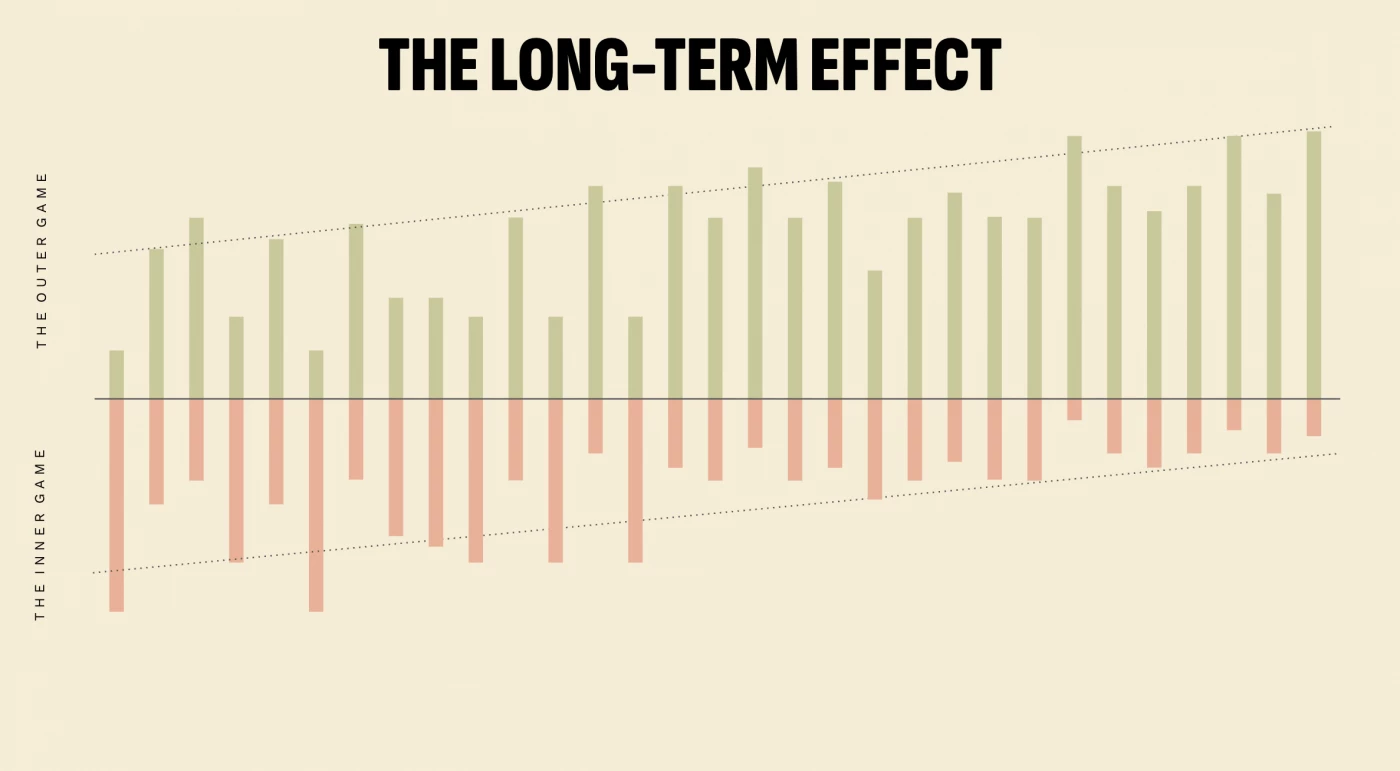
A few weeks later, Maya sits in the same Zoom meeting. The investor asks the same question: "Why aren't we growing faster?" But this time, Maya feels her heart rate elevate and simply notices it. She takes a breath, leans forward, and begins: "You're right, and I'm glad you're bringing this up. Here's what we've learned from talking to our churned customers, and here's our plan to fix it..."
The numbers are still challenging. The work is still hard. But something fundamental has shifted. Maya is no longer riding the rollercoaster blindfolded. She’s learned to see the track, anticipate the turns, and make adjustments from a place of centered commitment instead of reactive attachment.
She's become the founder her company needs her to be.
The truth is simple but not easy: you cannot control the external rollercoaster of entrepreneurship, but you can master your internal relationship to it. That mastery, the ability to stay committed while holding outcomes lightly, is the difference between founders who burn out and founders who build lasting impact.
The choice is always yours. Shaky or uplifted. Attached or free.
What will you choose in your next hard moment?
What This Means for You
The path from shaky to uplifted isn't about eliminating emotions or becoming detached. It's about changing your relationship with uncertainty. Low attachment doesn’t mean no attachment. That would mean you’re a robot or psychopath. It means processed attachment. You can care deeply while staying above the emotional turbulence.
When you master low attachment, high commitment, you stop riding the emotional rollercoaster. You start observing it. You make decisions from clarity rather than reactivity. You lead from strength rather than desperation.
The founders who scale aren't the ones who never face challenges. They're the ones who've learned to face challenges without being consumed by them.
That resistance you're feeling right now? That voice saying, "But what if I'm not ready?" or "My team needs me to have all the answers?" That's not wisdom talking. That's attachment.
You don't have to fix everything today. You just have to start by being honest with yourself. The courage you’re looking for isn’t the absence of fear. It’s feeling the fear and choosing commitment anyway.
Remember: this isn't a one-time exercise. You're training a muscle that's been conditioned over years to grip tightly and react defensively. The old patterns will resurface, especially under stress. That's not failure. That's your nervous system doing what it was trained to do. The goal isn't perfection. It's faster recognition and quicker recovery.
Notes
[1] This is a simplified model of a complex system. In reality, your beliefs, thoughts, emotions, and actions constantly influence each other in a loop. And in high-threat moments, your body can react before your conscious thoughts catch up.
*This story is inspired by real coaching work with founders. Details have been adapted and names anonymized to protect confidentiality. The examples are written for learning purposes and do not describe any one individual.


